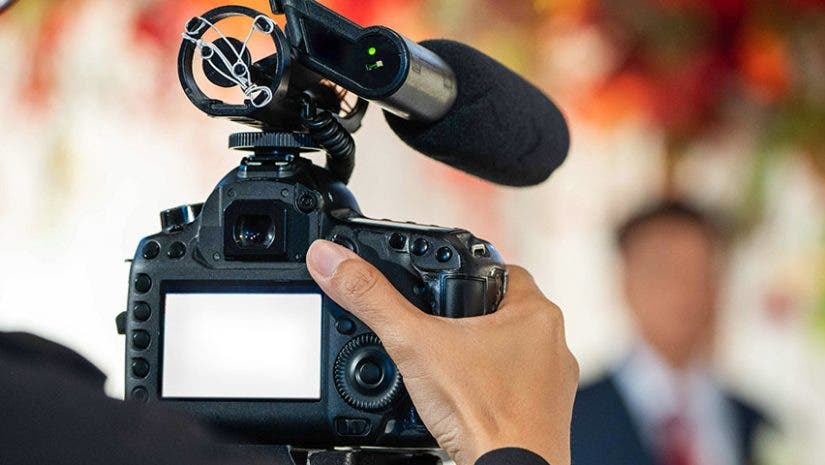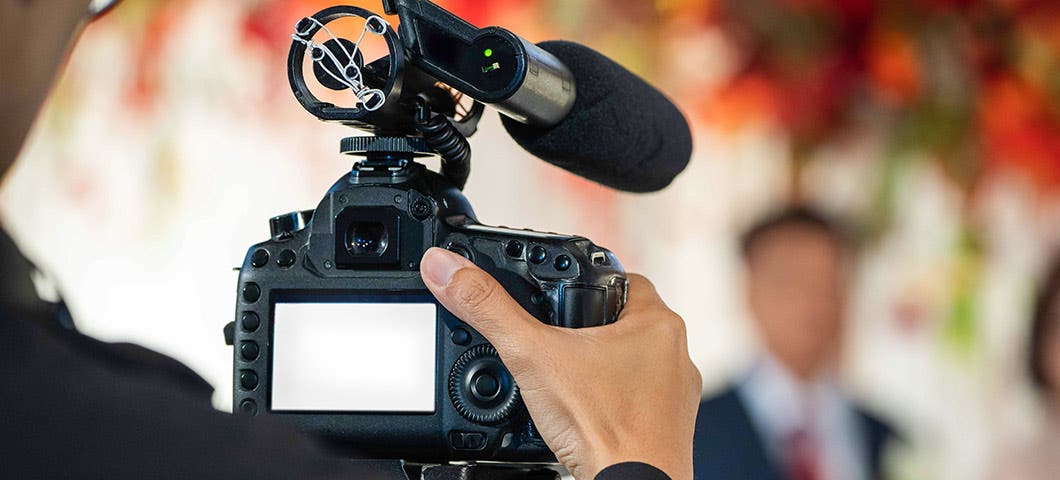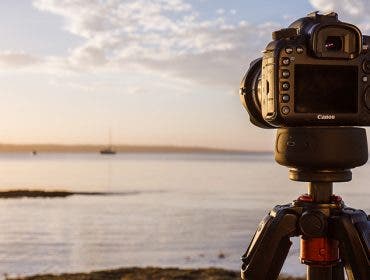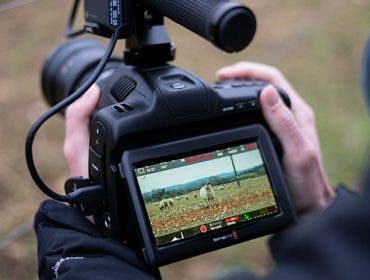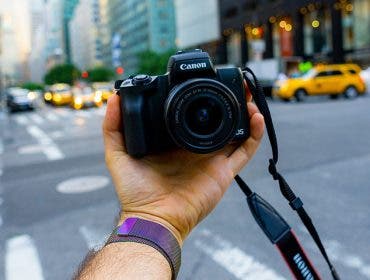If you’re filming with a state-of-the-art DSLR or mirrorless camera, the built-in microphone is often insufficient. Built-in microphones are often minuscule and offer very little flexibility in terms of audio level adjustments. By investing in a shotgun microphone, you can capture proper directional audio for your film or video.
Shotgun mics (or boom mics) will help you achieve the best sound quality for your production. They offer clear and high-quality audio for your footage by picking up specific sounds without recording other undesirable audio sources. This is why they’re crucial parts of your filmmaking gear, especially if you’re creating documentaries or narrative movies.
If you’re keen on buying the best shotgun mic for filmmaking, we’ve rounded up some options that you can get for your next shoot.
What to look for in a shotgun mic for filmmaking
Polar Pattern
By design, all shotgun mics have a tight pickup pattern. They’ll record whatever they’re pointed at and will reject a significant amount of off-axis noise. Because film sets and locations tend to be noisier and less controlled than a recording studio environment, shotgun microphones help keep on-set audio as clean as possible.
Directional polar patterns include cardioid, supercardioid, and hypercardioid. Many shotgun mics utilize a line-gradient design, which offers even more directionality than the average polar pattern. The best shotgun mic for filmmaking has maximum off-axis sound rejection for crystal-clear takes.
Frequency Response
Human hearing ranges from 20 Hz to 20,000 Hz. Many shotgun microphones have a full-spectrum frequency response, meaning they can reproduce all of the frequencies humans can discern. It’s also common to find a microphone that starts around 40 or 50 Hz and captures up to 20 kHz. Depending on the situation, you may not want a microphone that goes as low as 20 Hz in order to eliminate excess rumble at the source.
Maximum Sound Pressure Level
Microphones can withstand a certain level of volume before they distort. This is known as the maximum SPL rating. The lowest common rating is around 120 dBSPL. For context, that’s right around the level that begins to be physically uncomfortable, so it’s incredibly high. If you’ll be recording very loud sounds, find a shotgun mic with lots of maximum SPL headroom.
Power Requirements
Shotguns are a style of condenser mic, which requires external power to operate. Some shotguns, like those mounted to DSLR cameras, run on batteries. A standard XLR shotgun mic might give you the choice to run on batteries or on phantom power supplied by an audio interface or field recorder.
Camera-Mounted or Boom Operated
Camera-mounted shotgun mics are convenient on smaller productions shooting DSLRs. Many times they also record audio straight to the camera, so the setup is streamlined. For all other purposes, including larger productions, a professional shotgun mounted to a boom pole is standard.
Additional Features (Filters, Pads)
Finally, the best shotgun mic for filmmaking includes additional features like high-pass filters and pads. Filters give you the option to cut low-end information up to a certain frequency, which helps keep the signal clean under certain circumstances. Pads are a buffer that reduces the level of incoming signal, so you can safely record loud sound sources without worrying about distortion.
The Top Shotgun Microphones for Filmmaking

- RODE VideoMic Pro
- Sennheiser MKH-416
- Shure VP83F
- RODE VideoMic Pro+
- Sennheiser MKE 600
- RODE NTG-3
- Tascam TM-2X
- RODE NTG-4
- Canon DM-E1
- Audio-Technica AT897
RODE VideoMic Pro
Specially made for camcorders and DSLR cameras, the VideoMic Pro features a ½” condenser capsule and a 3.5mm minijack connector for broadcast-quality sound. The minijack connector gives you a 14dB self-noise level as well. This shotgun microphone decreases other audio sources and fully records your subject with its super-cardioid polar pattern. It also doesn’t record low-end noises, thanks to an 80 Hz high-pass filter.
The VideoMic Pro features a built-in Rycote Lyre-based shock mounting system, which prevents external elements from making it rumble and vibrate. It also boasts -10dB attenuation for loud sound recording and a +20dB level boost if you’re using the VideoMic Pro on your DSLR. The latter helps lessen the amount of noise generated by your camera’s mic by decreasing its pre-amp or mic input level — making the VideoMic Pro our best shotgun mic for DSLR cameras.
Key Specifications:
- Directional Pattern: Supercardioid
- Frequency Response: 40 Hz – 20 kHz
- Maximum Sound Level: 134 dB
- Power Requirement/s: 1 x 9V Alkaline Battery
- Output / Connector: 1 x ⅛” (3.5mm) Stereo Minijack Connector
- Weight: 85 g / 3 oz
Sennheiser MKH-416
The next best shotgun mic for film on our list handles tough filming situations easily with increased directivity, low self-noise levels, and increased consonant articulation. This Sennheiser boom mic even rejects unwanted feedback from other sound sources in harsh conditions. It controls excess mic noise using radio-frequency (RF) technology and enables better low noise performance through an optimized acoustic impedance in its transducer.
The MKH-416 comes in an RF condenser design, which makes it very resistant to humidity. The structure also gives you low noise while you pick up specific audio. You’ll even get less arcing and DC-bias creeping currents with low RF voltage across the transducer’s elements. Lastly, the MKH-416 features a hypercardioid pattern that captures sounds at low and medium frequencies; it also yields a lobar pattern at over 2 kHz.
Key Specifications:
- Directional Pattern: Hypercardioid / Lobar
- Frequency Response: 40 – 20,000 Hz
- Maximum Sound Level: 130 dB
- Power Requirement/s: 48V Phantom Power
- Output / Connector: XLR-3M Output
- Weight: 175 g / 5.82 oz
Shure VP83F
With ultra-clear and precise audio recording capabilities, the VP83F shotgun mic lets you pick up specific audio sources using super-cardioid and lobar patterns. It even reproduces natural sound through its broad frequency range. The VP83F boasts the integrated Rycote Lyre mounting system and an RF condenser design. Both features yield less vibration and mechanical noise and remove undesirable noise when this Shure mic is on your DSLR.
The VP83F is portable and durable, as it comes in a compact, metallic shotgun design. This factor makes it easier to carry between shoots. It gives you intuitive access to advanced monitoring, filtering, gain, track, and playback controls, too. You’ll even get built-in SD card recording and 10-hour recording time on your DSLR.
Key Specifications:
- Directional Pattern: Super-cardioid / Lobar
- Frequency Response: 50 Hz – 20 kHz
- Maximum Sound Level: 129 dB
- Power Requirement/s: 2 x AA Alkaline / NiMH / Rechargeable Li-ion Batteries
- Output / Connector: 1 x ⅛” (3.5 mm) Dual Mono Unbalanced Connector (for Cameras)
- Weight: 215 g / 7.6 oz
RODE VideoMic Pro+
Just like the original VideoMic Pro, you can use this RODE shotgun microphone with your DSLR camera or camcorder. The VideoMic Pro+ still uses the Rycote Lyre mounting system, but it also boasts a better mic design and a few new features. These advanced features include digital switching, which allows full capture of audio signals. This function ultimately lessens post-production and editing work.
The VideoMic Pro+ also features an automatic power function that shuts it off once you’ve unplugged it from your camera. The microphone even has a built-in battery door for easier battery replacement. You can power it up with RODE’s lithium-ion battery or AA batteries, or via a Micro USB connection.
Key Specifications:
- Directional Pattern: Supercardioid
- Frequency Response: 20 Hz – Approx. 20 kHz
- Maximum Sound Level: 133 dB
- Power Requirement/s: 1 Lithium-ion Rechargeable Battery / 2 x AA Batteries / Micro USB Port
- Output / Connector: 1 x ⅛” (3.5mm) Stereo Jack with Dual Mono Output
- Weight: 122 g / 4.3 oz
Sennheiser MKE 600
With a portable and short design, this Sennheiser boom mic for DSLR cameras and camcorders can tackle challenging audio situations. The MKE 600 will work great while you’re recording outdoors, thanks to a durable and metallic capsule. It even enables easier mounting on your DSLR through a built-in camera shoe and shock mount.
The MKE 600 simultaneously records on-camera audio and gives you less undesirable audio from your camera’s sides and rear using increased directivity. It also provides less wind noise through a foam windshield and extra wind for your recordings with a switchable low-cut filter. The filter reduces noise as well. To top it all off, you can power this shotgun microphone via phantom power or a single AA battery.
Key Specifications:
- Directional Pattern: Super-cardioid / Lobar
- Frequency Response: 40 Hz – 20 kHz
- Maximum Sound Level: 132dB on Phantom Power; 126dB on Battery
- Power Requirement/s: 48V Phantom Power via XLR-3 / 1 AA Battery
- Output / Connector : 1 XLR
- Weight: 128 g (Without Battery) / 4.5 oz
RODE NTG-3
As a boom mic for film, the NTG-3 delivers excellent and resonant sound alongside a clear frequency response. It’s virtually immune to moisture in challenging shooting environments as it incorporates RF technology. It’s also very durable, as it’s fashioned from sturdy brass with a nickel coating.
The NTG-3 will always pick up clear audio whether you mount it on your DSLR or on a boom pole. This is because it uses an accurate polar pattern. The pattern also rejects off-axis noise well and gives you a longer range for audio recording. The NTG-3 even rejects unwanted noise and interference from radio antennas, Wi-Fi networks, and other similar sources using RF interference properties.
Key Specifications:
- Directional Pattern: Line-Gradient Supercardioid
- Frequency Response: 40 Hz – 20 kHz
- Maximum Sound Level: 130 dB
- Power Requirement/s: 48V Phantom Power
- Output / Connector: 3-pin XLR Connector
- Weight: 163 g / 5.74 oz
Tascam TM-2X
Featuring an X-Y stereo condenser design, Tascam’s TM-2X delivers high audio quality for high-quality DSLR movies. The X-Y pattern produces less hollowed audio as it records, making it an effective method of picking up desired sounds. This shotgun microphone also features a vari-angle structure with 180° rotation for complete focus on your subject. It even records loud sounds clearly as it has a maximum sound level of 120dB.
The TM-2X and its shoe mount also come in a floating design for less mic noise. There’s even a noise isolation arm that delivers less noise while you use the mic on your DSLR. And just like typical shotgun mics, the TM-2X features a low-cut filter and a fur windscreen for less low-frequency and wind noise. You can use it on mirrorless cameras, compact models, and video cameras as well since it doesn’t have any digital circuits.
Key Specifications:
- Directional Pattern: Cardioid
- Frequency Response: 50 Hz – 20 kHz
- Maximum Sound Level: 120 dB
- Power Requirement/s: Plug-in Power
- Output / Connector: 1 x ⅛” (3.5mm) TRS Stereo Mini Plug
- Weight: 75 g / 2.6 oz
RODE NTG-4
Whether you mount it on a camera or on a boom pole, the NTG-4 will record high-quality audio for your production. A new condenser capsule inside this boom mic delivers low noise, higher sensitivity, and resonant, smooth sound. The NTG-4 picks audio up through a super-cardioid pattern and features a 20 to 20,000 Hz frequency response. And if you use phantom power on the microphone, it will provide 135 dB of sound for loud sound pick-up.
The NTG-4 features digital switching on its body, giving you control over its built-in high-pass filter, pad, and high-frequency boost. The high-pass filter delivers low frequency and infrasonic rumble reduction, while the pad lets you record clip-free loud audio. On the other hand, the high-frequency boost brings back lost high-frequency sound and achieves clearer recordings. This feature even maintains your custom settings as you turn the microphone off by incorporating continuous states.
Key Specifications:
- Directional Pattern: Super-cardioid
- Frequency Response: 20 – 20,000 Hz
- Maximum Sound Level: 135 dB
- Power Requirement/s: Phantom Power (12V / 24V / 48V)
- Output / Connector: 3-Pin XLR
- Weight: 126 g / 4.44 oz
Canon DM-E1
If you’re shooting a movie with a Canon DSLR camera, the DM-E1 will help you get high-quality sound for your footage. It delivers operational noise and vibration isolation through a shock mount design, which gives you fewer vibrations and lets you record your desired sounds. You can also easily switch between the mic’s Shotgun and Stereo modes with its directivity switch.
For outdoor shoots, Canon has included a windscreen along with this shotgun microphone. The accessory reduces wind noise, which maintains audio focus. The DM-E1 can also pick up various sounds throughout a 50 Hz to 16 kHz frequency range. These sounds include nature sounds, such as rumbling waves and high-pitched bird songs.
Key Specifications:
- Directional Pattern: Sharp / Single Directivity
- Frequency Response: 50 Hz – 16 kHz
- Maximum Sound Level: Unknown
- Power Requirement/s: 1 x Button-Cell Type Lithium Battery
- Output / Connector: 1 x 3.5mm Mini Plug
- Weight: 110 g / 3.9 oz
Audio-Technica AT897
Rounding out our best shotgun mic for film list, the AT897 features a line-gradient design with a narrow angle. This structure lets it capture audio from long distances remarkably. The microphone also delivers smooth and natural sound coming from its axis while rejecting off-axis sound from its sides and rear. It even features a built-in low-cut frequency switch for less noise and humming at low frequencies.
You won’t have to worry about the AT897 blocking your view while you’re shooting essential footage for your film. It measures 11″ so it stays outside your current frame. This characteristic gives you an advantage, especially if you’ve mounted the AT897 on a portable video camera. As an extra bonus, this boom mic runs on batteries or phantom power.
Key Specifications:
- Directional Pattern: Line-Gradient
- Frequency Response: 20 Hz – 20 kHz
- Maximum Sound Level: 129 dB (on Phantom Power)
- Power Requirement/s: 1 x AA Battery / Phantom Power (11-52V)
- Output / Connector: 1 x 3-Pin XLR
- Weight: 145 g / 5.11 oz
Why Do You Need an External Microphone?
Most DSLR cameras, mirrorless cameras, and camcorders contain an onboard microphone, but in nearly all cases these microphones are exceedingly limited in strength, capability, and quality. They also have a very wide pickup pattern, so they capture any and all noise on set. Audio recorded with an onboard microphone is weaker, contains more ambient noise, and is harder to control.
An onboard microphone also requires the subject to speak directly toward the camera for even passable results. That isn’t to say that onboard microphones are totally useless. Onboard microphones can help with post production. The audio they capture can synchronize seamlessly with sound from external microphones. By matching the wave forms from each audio signal, you can create perfect audio alignment.
Improved Audio Quality for Filmmaking
Using an external microphone, like a shotgun mic, offers numerous benefits for filmmakers. Investing in a professional microphone and other key sound equipment always results in improved audio quality for your footage.
If you want nuanced and controllable sound levels, an external professional microphone is the only way to go. Just like photographers prefer to use an off-camera flash to create a dynamic lighting look, using a dedicated microphone for filmmaking that’s not mounted on the camera body can deliver superior audio.
External microphones also make it possible to record audio from any location. You can easily place your audio recording equipment anywhere on set to achieve better results. Filmmakers no longer need to worry about their subjects facing the camera for optimal sound quality. Standalone professional audio equipment captures sound from anywhere on set.
What are the Benefits of Using a Shotgun Mic?
Many filmmakers prefer shotgun mics for their compact size, reliable versatility, and excellent audio quality. Shotgun mics are ideal microphones for film because of their narrower pickup pattern than your camera’s onboard microphone. The result is clearer audio and decreased background noise.
Another benefit of using a shotgun mic is the sensitivity of the sound recording. Shotgun mics can pick up sound from farther away when compared to other types of microphones like lavalier mics. The typical range for shotgun mics is six to ten feet, so while you can’t capture audio from great distances, you can easily record sound in most indoor environments.
More Natural, Conversational Sound
When it comes to selecting a professional microphone for video recording, a shotgun mic offers many other benefits as well. Performers don’t have to worry about projecting their voices unnaturally, so the resulting audio sounds much more conversational. That’s true even for budget microphones in the shotgun category.
Shotgun mics are ideal for video recording because you can mount them on the camera or off. Use them with a boom pole for better control and proximity to the performers, or hide them just out of frame.
One of the biggest benefits of using a shotgun mic is that you don’t need to worry about a power supply (in most cases). Many shotgun mics receive power from recording devices like cameras or audio recorders. This helps filmmakers maintain a much more streamlined sound equipment kit.
What is the Sound Pattern of a Shotgun Microphone?
Shotgun mics are directional microphones with a very unique polar pattern when recording sound. Most of the microphone’s sensitivity comes from a single direction, so the clearest audio will always come from sounds directed at the microphone.
Shotgun mics also have three other areas (lobes) of sound-recording sensitivity. There’s a small area of sensitivity on either side of the microphone, and a somewhat larger area on the rear of the microphone. Even with these additional areas of sound sensitivity, shotgun mics are still directional microphones. But it’s important to know about these three alternate areas of potential sound pickup.
Shotgun Mics are Directional Microphones
Essentially, a shotgun mic is strongest when sound comes from right in front of it. However, some shotgun mics, and especially budget microphones, will also capture sound from the sides and rear of the microphone.
The exact polar pattern of each directional microphone will vary, so before you purchase your next microphone for video recording, check the information from the manufacturer. Some microphones have virtually no lobes of sensitivity on the sides, while others have more significant sensitivity in those areas.
Compared to other types of microphones for film and audio recording, shotgun mics are the most directional microphones available. However, the range of directionality varies from microphone to microphone. Some shotgun mics have a wider front-capture zone, while others feature a more narrow on-axis recording range.
What Other Sound Equipment is Needed for Filmmaking?
Investing in a professional microphone is the first vital step in assembling an audio recording equipment kit, but you’ll also want to consider a few other components.
If you intend to film subjects from very far away or with an extremely wide camera angle, a shotgun mic won’t work as well as other varieties. Getting the microphone close enough to capture sound naturally may encroach on your shot. Nothing says “low budget filmmaking” like a boom mic appearing at the top of the frame!
For these wider shots, a carefully disguised lavalier mic or wireless microphone may be more appropriate. As long as the microphone isn’t visible, you’re free to film from wherever you’d like with no concern about sound quality.
If you plan to use your shotgun microphone exclusively for video recording, then you’ll need a few helpful sound equipment accessories.
Windshields
A windshield prevents wind from blowing against the microphone and creating excessive noise or interference. Windshields often look furry, so for that reason they’re also referred to as “dead cats.” The surface area of the fur increases sound blocking properties.
Boom Poles
If you want to film with your shotgun mic off your camera, then you’ll need a boom pole. A boom pole can be held above or below the performer depending on the camera angle you had in mind. Telescoping boom poles are helpful pieces of audio recording equipment because they can adapt to the size and distance of your shot.
Audio Recorders
If you want to capture sound with a boom pole but still need to use your directional microphone from far away, you can plug the mic into an audio recorder. In post production, you’ll sync the sound recorded on the recorder with your filmed footage.
Feature image via Shutterstock
